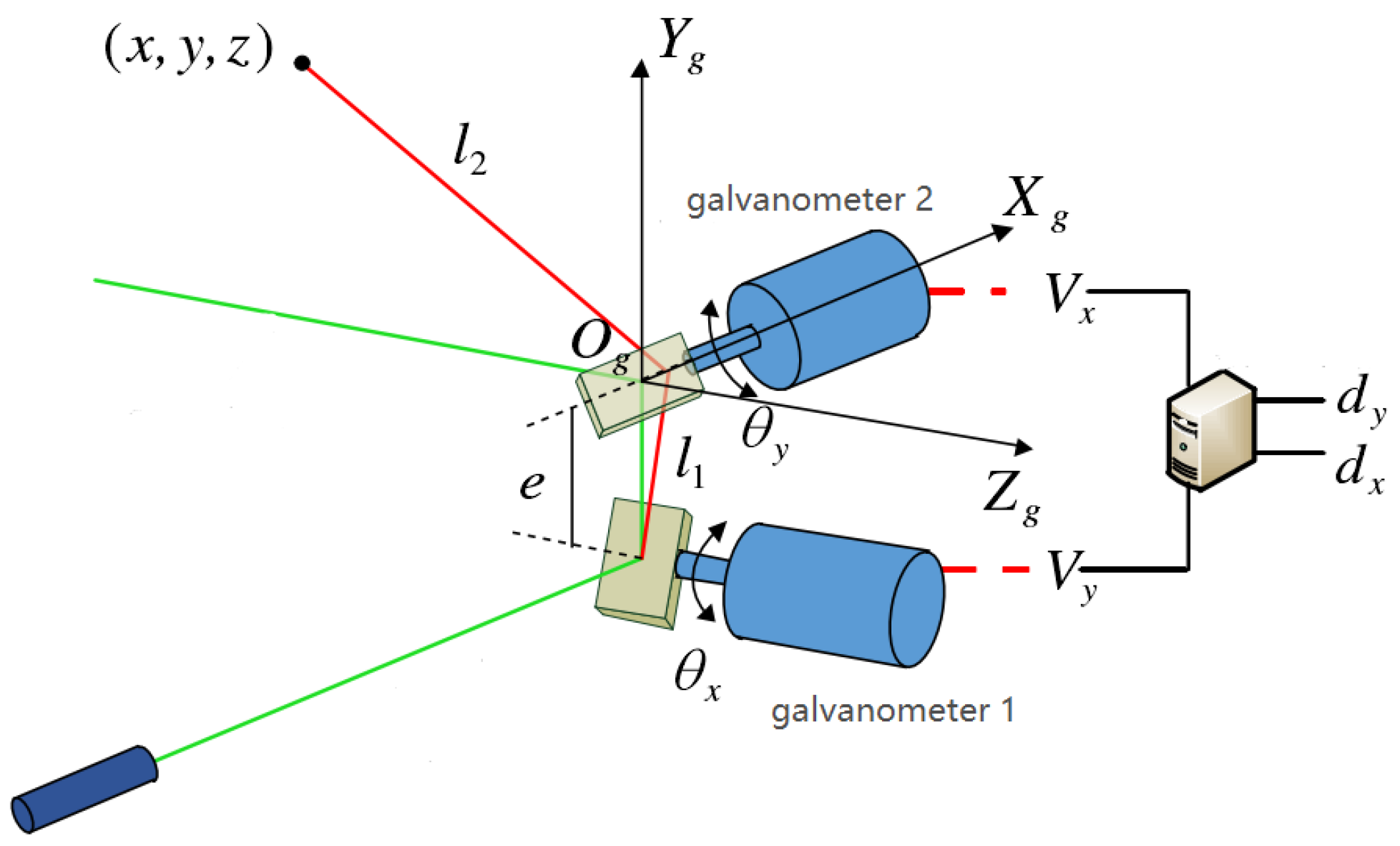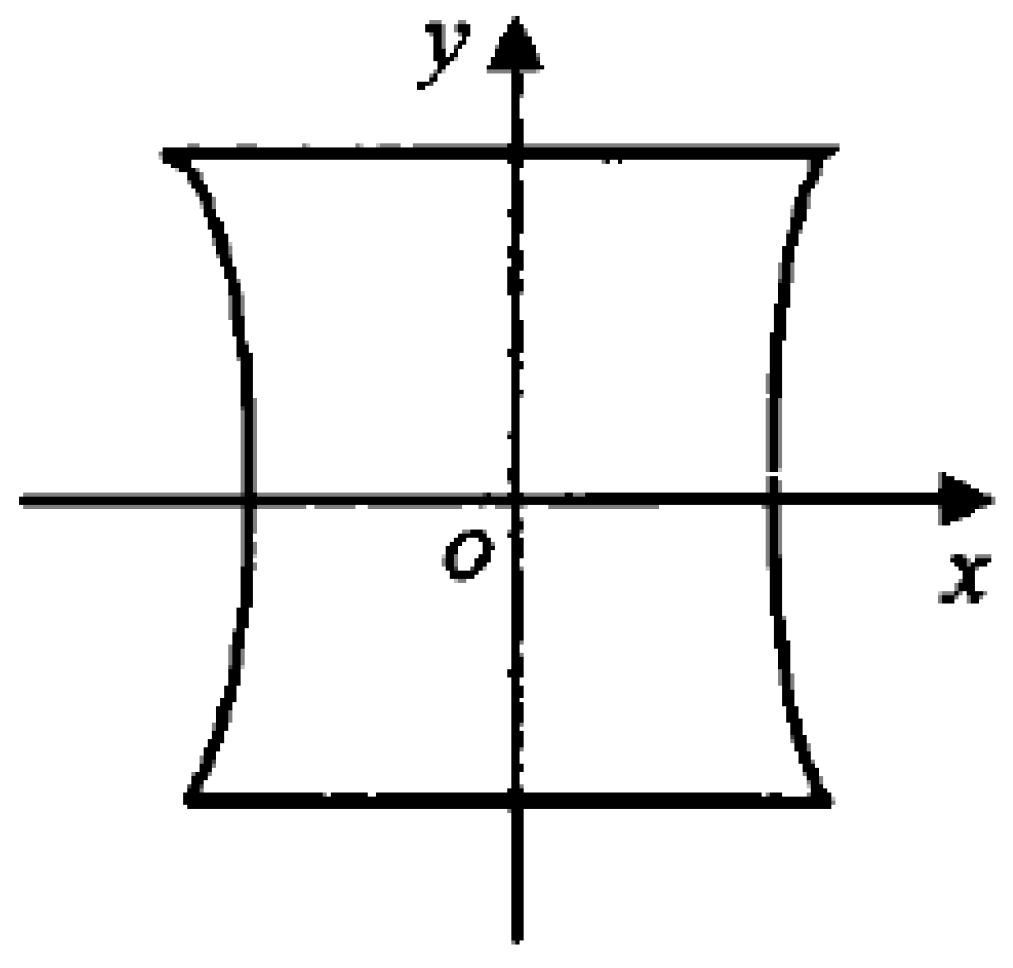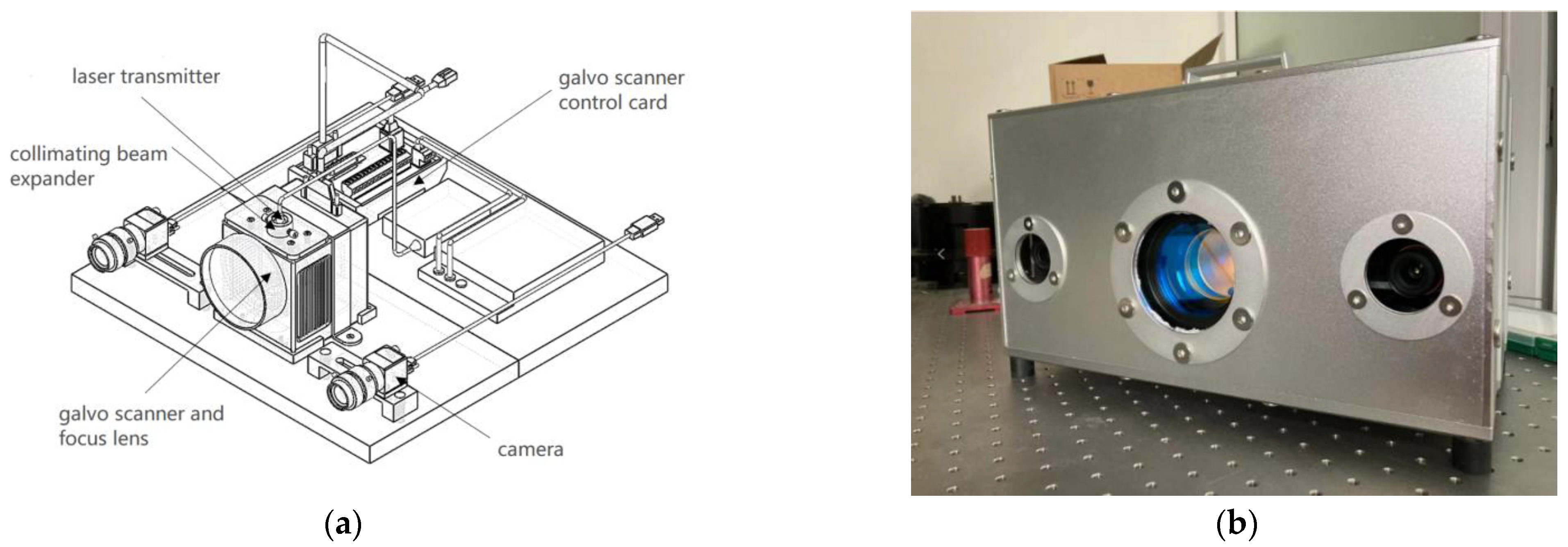Calibrating Laser Three-Dimensional Projection Systems Using Binocular Vision
Abstract
1. Introduction
2. Calibration Method Based on Binocular Vision
2.1. Positioning Theory for Binocular Vision
2.2. Calibration Using Binocular Vision
2.2.1. Simplifying the Computational Model of Galvanometers Using Binocular Vision
2.2.2. Solve Calibration Directly Using Data-Driven Approach
3. Projection System Calibration Experiment and Result Analysis
3.1. Projection System Calibration Experiment
- The relative position of the camera and galvo scanner in the laser 3D projection device remain unchanged. Moreover, a set of drive values is predetermined to deflect the laser by an angle such that it is projected on the projection working range (1.8–2.2 m in this experiment) to generate a spot.
- The laser 3D projection system is adjusted such that the binocular camera can clearly obtain the laser spot image. Moreover, the internal and external parameters of the binocular camera are calibrated. The positioning function of binocular vision is used to obtain the spatial coordinates of the spot and match the deflection values of the galvo scanner.
- Steps one and two are repeated to obtain the 3D coordinates of multiple groups of different outgoing laser spots and matching deflection values of the galvo scanner. The neural network is used to solve the relationship between the coordinates of the camera coordinate system and deflection values of the galvanometer.
- The position of the projected target with marking points is fixed, and a world coordinate system is established. The positioning function of binocular vision is used to obtain the coordinates of the four marking points on the projected target in the camera coordinate system. The transformation matrix between the two coordinate systems is solved after determining the coordinates of the four points.
- The corresponding relationship between the deflection values of the galvo scanner and coordinates of the coordinate system of the object to be projected can be obtained by combining steps three and four. Thereafter, the system calibration is completed.
3.2. Results Analysis
4. Conclusions
Author Contributions
Funding
Institutional Review Board Statement
Informed Consent Statement
Data Availability Statement
Conflicts of Interest
References
- Wang, M. Research on Machine-Vision-Aided Three Dimensional Laser Scan Indication. Master’s Thesis, Nanjing University of Aeronautics and Astronautics, Nanjing, China, 2017. [Google Scholar]
- Kaufman, S.; Savikovsky, A.; Chagaris, C. Laser Projection with Object Feature Detection. U.S. Patent 7,306,339, 11 December 2007. [Google Scholar]
- Liu, M. Research on Key Technique and Application of the Precise 3D Optical Projecting Indication System. Ph.D. Thesis, Tianjin University, Tianjin, China, 2016. [Google Scholar]
- Li, D.; Deng, L.; Duan, J.; Zheng, X.; You, X. Study on large scale 3-D laser dynamic scanning manufacturing systems. Laser Technol. 2016, 40, 466–471. [Google Scholar]
- Chen, Y. Research on Autonomous Scanning Laser Projection Technology Integrating integrated with Photogrammetry. Master’s Thesis, Changchun University of Science and Technology, Changchun, China, 2021. [Google Scholar]
- Rueb, K.; Bordignon, R.; Wieczorek, J. 3D Imaging Using a Laser Projector. U.S. Patent 5,661,667, 26 August 1997. [Google Scholar]
- Kaufman, S.; Savikovsky, A. Apparatus and Method for Projecting a 3D Image. U.S. Patent 6,547,397, 14 April 2003. [Google Scholar]
- Cui, S.; Zhu, X.; Wang, W.; Xie, Y. Calibration of a Laser Galvanometric Scanning System by Adapting a Camera Model. Appl. Opt. 2009, 48, 2632–2637. [Google Scholar] [PubMed]
- Guo, L. Research on Intelligent Laser 3D Projection System and Calibration Technique for Spatial Positioning Accuracy. Ph.D. Thesis, Changchun University of Science and Technology, Changchun, China, 2018. [Google Scholar]
- Rueb, K.; Jackson, V.; Morden, J. Laser Projection Systems and Methods. U.S. Patent 7,986,417, 26 July 2011. [Google Scholar]
- Kaufman, S.; Mettinen, K.; Mohazzab, M. 3D Laser Projection, Scanning and Object Tracking. U.S. Patent 9,826,207, 21 November 2017. [Google Scholar]
- Tobias, W.; Benjamin, W.; Patrick, S. Data-Driven Learning for Calibrating Galvanometric Laser Scanners. IEEE Sens. J. 2015, 15, 5709–5716. [Google Scholar]
- Morden, J.; Rueb, K. Laser Projection System, Intelligent Data Correction System and Method. U.S. Patent 7,463,368, 9 December 2008. [Google Scholar]
- Qi, L.; Zhang, Y.; Wang, S.; Tang, Z.; Yang, H.; Zhang, X. Laser cutting of irregular shape object based on stereo vision laser galvanometric scanning system. Opt. Lasers Eng. 2015, 68, 180–187. [Google Scholar]
- Tu, J.; Zhang, L. Effective data-driven calibration for a galvanometric laser scanning system using binocular stereo vision. Sensors 2018, 18, 197. [Google Scholar] [CrossRef] [PubMed]
- Moreno Noguer, F.; Lepetit, V.; Fua, P. EPnP: Accurate Non-Iterative O(n) Solution to the PnP Problem. In Proceedings of the IEEE 11th International Conference on Computer Vision, Rio de Janeiro, Brazil, 14–21 October 2007; pp. 1–8. [Google Scholar]
- Dhond, U.; Aggarwal, J. Structure from stereo-a review. Syst. Man Cybern. IEEE Trans. 1989, 19, 1489–1510. [Google Scholar]
- Warren, M.; Walter, P. A Logical Calculus of the Ideas Immanent in Nervous Activity; Springer: Berlin/Heidelberg, Germany, 1986; Volume 52, pp. 229–230. [Google Scholar]













| Number of Training Sets | Number of Hidden Layer Neurons | Mean Deviation/mm | Maximum Deviation/mm | Computing Time/h |
|---|---|---|---|---|
| 1000 | 2000 | 1.15 | 6.52 | 0.18 |
| 2000 | 3000 | 1.03 | 4.11 | 0.41 |
| 4000 | 5000 | 0.76 | 4.01 | 1.1 |
| 8000 | 9000 | 0.52 | 1.65 | 3.5 |
| 11,000 | 12,000 | 0.37 | 0.87 | 6.2 |
| 14,000 | 15,000 | 0.31 | 0.64 | 10.4 |
| 19,000 | 20,000 | 0.28 | 0.66 | 18.3 |
| Working Distance/m | Mean Deviation/mm | Maximum Deviation/mm |
|---|---|---|
| 1.8 | 0.43 | 0.75 |
| 1.9 | 0.31 | 1.41 |
| 2.0 | 0.35 | 0.79 |
| 2.1 | 0.39 | 0.95 |
| 2.2 | 0.44 | 0.52 |
| Calibration Method | Mean Deviation/mm | Structural Complexity | Calibration Time | |
|---|---|---|---|---|
| Establish physical model | Newton iterative algorithm [9] | 0.88 | Complex | 2 h Recalibration required |
| Levenberg–Marquardt algorithm [9] | 0.32 | |||
| Hybrid particle swarm algorithm [9] | 0.998 | |||
| Binocular vision calibration method based on the coordinate system | 0.5 | Complex | 6 h No recalibration required | |
| Method in this article | 0.37 | Simple | 7 h No recalibration required | |
Disclaimer/Publisher’s Note: The statements, opinions and data contained in all publications are solely those of the individual author(s) and contributor(s) and not of MDPI and/or the editor(s). MDPI and/or the editor(s) disclaim responsibility for any injury to people or property resulting from any ideas, methods, instructions or products referred to in the content. |
© 2023 by the authors. Licensee MDPI, Basel, Switzerland. This article is an open access article distributed under the terms and conditions of the Creative Commons Attribution (CC BY) license (https://creativecommons.org/licenses/by/4.0/).
Share and Cite
Lao, D.; Wang, Y.; Wang, F.; Gao, C. Calibrating Laser Three-Dimensional Projection Systems Using Binocular Vision. Sensors 2023, 23, 1941. https://doi.org/10.3390/s23041941
Lao D, Wang Y, Wang F, Gao C. Calibrating Laser Three-Dimensional Projection Systems Using Binocular Vision. Sensors. 2023; 23(4):1941. https://doi.org/10.3390/s23041941
Chicago/Turabian StyleLao, Dabao, Yukai Wang, Fang Wang, and Chao Gao. 2023. "Calibrating Laser Three-Dimensional Projection Systems Using Binocular Vision" Sensors 23, no. 4: 1941. https://doi.org/10.3390/s23041941
APA StyleLao, D., Wang, Y., Wang, F., & Gao, C. (2023). Calibrating Laser Three-Dimensional Projection Systems Using Binocular Vision. Sensors, 23(4), 1941. https://doi.org/10.3390/s23041941






